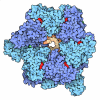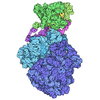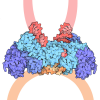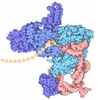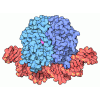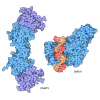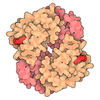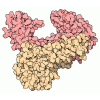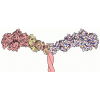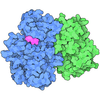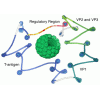[English] 日本語
 Yorodumi
Yorodumi- PDB-9gfb: CryoEM structure of the human INO80 core-nucleosome complex state N-7 -
+ Open data
Open data
- Basic information
Basic information
| Entry | Database: PDB / ID: 9gfb | |||||||||||||||||||||
|---|---|---|---|---|---|---|---|---|---|---|---|---|---|---|---|---|---|---|---|---|---|---|
| Title | CryoEM structure of the human INO80 core-nucleosome complex state N-7 | |||||||||||||||||||||
 Components Components |
| |||||||||||||||||||||
 Keywords Keywords | DNA BINDING PROTEIN / Homo sapiens / ATP-dependent chromatin remodeller | |||||||||||||||||||||
| Function / homology |  Function and homology information Function and homology informationpositive regulation of nuclear cell cycle DNA replication / promoter-enhancer loop anchoring activity / telomerase RNA localization to Cajal body / regulation of DNA strand elongation / positive regulation of telomere maintenance in response to DNA damage / establishment of protein localization to chromatin / R2TP complex / dynein axonemal particle / RPAP3/R2TP/prefoldin-like complex / Swr1 complex ...positive regulation of nuclear cell cycle DNA replication / promoter-enhancer loop anchoring activity / telomerase RNA localization to Cajal body / regulation of DNA strand elongation / positive regulation of telomere maintenance in response to DNA damage / establishment of protein localization to chromatin / R2TP complex / dynein axonemal particle / RPAP3/R2TP/prefoldin-like complex / Swr1 complex / Ino80 complex / ATP-dependent chromatin remodeler activity / regulation of double-strand break repair / UV-damage excision repair / box C/D snoRNP assembly / protein folding chaperone complex / regulation of chromosome organization / NuA4 histone acetyltransferase complex / TFIID-class transcription factor complex binding / regulation of DNA replication / mitotic sister chromatid segregation / regulation of G1/S transition of mitotic cell cycle / MLL1 complex / regulation of embryonic development / Telomere Extension By Telomerase / ATP-dependent activity, acting on DNA / alpha-tubulin binding / RNA polymerase II core promoter sequence-specific DNA binding / regulation of DNA repair / negative regulation of megakaryocyte differentiation / positive regulation of double-strand break repair via homologous recombination / protein localization to CENP-A containing chromatin / spindle assembly / Chromatin modifying enzymes / Replacement of protamines by nucleosomes in the male pronucleus / CENP-A containing nucleosome / Packaging Of Telomere Ends / Recognition and association of DNA glycosylase with site containing an affected purine / Cleavage of the damaged purine / Deposition of new CENPA-containing nucleosomes at the centromere / Recognition and association of DNA glycosylase with site containing an affected pyrimidine / Cleavage of the damaged pyrimidine / telomere organization / telomere maintenance / DNA helicase activity / Interleukin-7 signaling / RNA Polymerase I Promoter Opening / Inhibition of DNA recombination at telomere / TBP-class protein binding / epigenetic regulation of gene expression / Meiotic synapsis / Assembly of the ORC complex at the origin of replication / positive regulation of DNA repair / SUMOylation of chromatin organization proteins / Regulation of endogenous retroelements by the Human Silencing Hub (HUSH) complex / DNA methylation / Condensation of Prophase Chromosomes / Chromatin modifications during the maternal to zygotic transition (MZT) / SIRT1 negatively regulates rRNA expression / HCMV Late Events / innate immune response in mucosa / ERCC6 (CSB) and EHMT2 (G9a) positively regulate rRNA expression / PRC2 methylates histones and DNA / cellular response to ionizing radiation / Regulation of endogenous retroelements by KRAB-ZFP proteins / Defective pyroptosis / HDACs deacetylate histones / Regulation of endogenous retroelements by Piwi-interacting RNAs (piRNAs) / Nonhomologous End-Joining (NHEJ) / RNA Polymerase I Promoter Escape / cellular response to estradiol stimulus / Transcriptional regulation by small RNAs / euchromatin / negative regulation of canonical Wnt signaling pathway / Formation of the beta-catenin:TCF transactivating complex / Activated PKN1 stimulates transcription of AR (androgen receptor) regulated genes KLK2 and KLK3 / double-strand break repair via homologous recombination / RUNX1 regulates genes involved in megakaryocyte differentiation and platelet function / HDMs demethylate histones / G2/M DNA damage checkpoint / ADP binding / beta-catenin binding / DNA Damage Recognition in GG-NER / NoRC negatively regulates rRNA expression / chromatin DNA binding / B-WICH complex positively regulates rRNA expression / DNA Damage/Telomere Stress Induced Senescence / PKMTs methylate histone lysines / Meiotic recombination / Pre-NOTCH Transcription and Translation / Hydrolases; Acting on acid anhydrides; Acting on acid anhydrides to facilitate cellular and subcellular movement / Metalloprotease DUBs / spindle / RMTs methylate histone arginines / Activation of anterior HOX genes in hindbrain development during early embryogenesis / nuclear matrix / fibrillar center / Transcriptional regulation of granulopoiesis / HCMV Early Events / antimicrobial humoral immune response mediated by antimicrobial peptide Similarity search - Function | |||||||||||||||||||||
| Biological species |  Homo sapiens (human) Homo sapiens (human)synthetic construct (others) | |||||||||||||||||||||
| Method | ELECTRON MICROSCOPY / single particle reconstruction / cryo EM / Resolution: 3.55 Å | |||||||||||||||||||||
 Authors Authors | Sharma, M. / Aggarwal, P. / Hopfner, K.P. | |||||||||||||||||||||
| Funding support | European Union,  Germany, 2items Germany, 2items
| |||||||||||||||||||||
 Citation Citation |  Journal: To Be Published Journal: To Be PublishedTitle: CryoEM structure of the human INO80 core-nucleosome complex state N-7 Authors: Sharma, M. / Aggarwal, P. / Hopfner, K.P. | |||||||||||||||||||||
| History |
|
- Structure visualization
Structure visualization
| Structure viewer | Molecule:  Molmil Molmil Jmol/JSmol Jmol/JSmol |
|---|
- Downloads & links
Downloads & links
- Download
Download
| PDBx/mmCIF format |  9gfb.cif.gz 9gfb.cif.gz | 1 MB | Display |  PDBx/mmCIF format PDBx/mmCIF format |
|---|---|---|---|---|
| PDB format |  pdb9gfb.ent.gz pdb9gfb.ent.gz | Display |  PDB format PDB format | |
| PDBx/mmJSON format |  9gfb.json.gz 9gfb.json.gz | Tree view |  PDBx/mmJSON format PDBx/mmJSON format | |
| Others |  Other downloads Other downloads |
-Validation report
| Summary document |  9gfb_validation.pdf.gz 9gfb_validation.pdf.gz | 1.8 MB | Display |  wwPDB validaton report wwPDB validaton report |
|---|---|---|---|---|
| Full document |  9gfb_full_validation.pdf.gz 9gfb_full_validation.pdf.gz | 1.9 MB | Display | |
| Data in XML |  9gfb_validation.xml.gz 9gfb_validation.xml.gz | 122 KB | Display | |
| Data in CIF |  9gfb_validation.cif.gz 9gfb_validation.cif.gz | 196.5 KB | Display | |
| Arichive directory |  https://data.pdbj.org/pub/pdb/validation_reports/gf/9gfb https://data.pdbj.org/pub/pdb/validation_reports/gf/9gfb ftp://data.pdbj.org/pub/pdb/validation_reports/gf/9gfb ftp://data.pdbj.org/pub/pdb/validation_reports/gf/9gfb | HTTPS FTP |
-Related structure data
| Related structure data |  51312MC  9gfmC M: map data used to model this data C: citing same article ( |
|---|---|
| Similar structure data | Similarity search - Function & homology  F&H Search F&H Search |
- Links
Links
- Assembly
Assembly
| Deposited unit | 
|
|---|---|
| 1 |
|
- Components
Components
-Protein , 8 types, 16 molecules ABCDEFGJMQNROSPT
| #1: Protein | Mass: 50296.914 Da / Num. of mol.: 3 Source method: isolated from a genetically manipulated source Source: (gene. exp.)  Homo sapiens (human) / Gene: RUVBL1, INO80H, NMP238, TIP49, TIP49A / Production host: Homo sapiens (human) / Gene: RUVBL1, INO80H, NMP238, TIP49, TIP49A / Production host:  Trichoplusia ni (cabbage looper) / References: UniProt: Q9Y265, DNA helicase Trichoplusia ni (cabbage looper) / References: UniProt: Q9Y265, DNA helicase#2: Protein | Mass: 51222.465 Da / Num. of mol.: 3 Source method: isolated from a genetically manipulated source Source: (gene. exp.)  Homo sapiens (human) / Gene: RUVBL2, INO80J, TIP48, TIP49B, CGI-46 / Production host: Homo sapiens (human) / Gene: RUVBL2, INO80J, TIP48, TIP49B, CGI-46 / Production host:  Trichoplusia ni (cabbage looper) / References: UniProt: Q9Y230, DNA helicase Trichoplusia ni (cabbage looper) / References: UniProt: Q9Y230, DNA helicase#3: Protein | | Mass: 177032.812 Da / Num. of mol.: 1 Source method: isolated from a genetically manipulated source Source: (gene. exp.)  Homo sapiens (human) / Gene: INO80, INO80A, INOC1, KIAA1259 / Production host: Homo sapiens (human) / Gene: INO80, INO80A, INOC1, KIAA1259 / Production host:  Trichoplusia ni (cabbage looper) Trichoplusia ni (cabbage looper)References: UniProt: Q9ULG1, Hydrolases; Acting on acid anhydrides; Acting on acid anhydrides to facilitate cellular and subcellular movement #6: Protein | | Mass: 68372.336 Da / Num. of mol.: 1 Source method: isolated from a genetically manipulated source Source: (gene. exp.)  Homo sapiens (human) / Gene: ACTR5, ARP5 / Production host: Homo sapiens (human) / Gene: ACTR5, ARP5 / Production host:  Trichoplusia ni (cabbage looper) / References: UniProt: Q9H9F9 Trichoplusia ni (cabbage looper) / References: UniProt: Q9H9F9#9: Protein | Mass: 15437.167 Da / Num. of mol.: 2 Source method: isolated from a genetically manipulated source Source: (gene. exp.)  Homo sapiens (human) Homo sapiens (human)Gene: HIST1H3A, H3FA, HIST1H3B, H3FL, HIST1H3C, H3FC, HIST1H3D, H3FB, HIST1H3E, H3FD, HIST1H3F, H3FI, HIST1H3G, H3FH, HIST1H3H, H3FK, HIST1H3I, H3FF, HIST1H3J, H3FJ Production host:  #10: Protein | Mass: 11263.231 Da / Num. of mol.: 2 Source method: isolated from a genetically manipulated source Source: (gene. exp.)  Homo sapiens (human) Homo sapiens (human)Gene: HIST1H4A, H4/A, H4FA, HIST1H4B, H4/I, H4FI, HIST1H4C, H4/G, H4FG, HIST1H4D, H4/B, H4FB, HIST1H4E, H4/J, H4FJ, HIST1H4F, H4/C, H4FC, HIST1H4H, H4/H, H4FH, HIST1H4I, H4/M, H4FM, HIST1H4J, H4/E, ...Gene: HIST1H4A, H4/A, H4FA, HIST1H4B, H4/I, H4FI, HIST1H4C, H4/G, H4FG, HIST1H4D, H4/B, H4FB, HIST1H4E, H4/J, H4FJ, HIST1H4F, H4/C, H4FC, HIST1H4H, H4/H, H4FH, HIST1H4I, H4/M, H4FM, HIST1H4J, H4/E, H4FE, HIST1H4K, H4/D, H4FD, HIST1H4L, H4/K, H4FK, HIST2H4A, H4/N, H4F2, H4FN, HIST2H4, HIST2H4B, H4/O, H4FO, HIST4H4 Production host:  #11: Protein | Mass: 14034.355 Da / Num. of mol.: 2 Source method: isolated from a genetically manipulated source Source: (gene. exp.)  Homo sapiens (human) / Gene: H2AC4, H2AFM, HIST1H2AB, H2AC8, H2AFA, HIST1H2AE / Production host: Homo sapiens (human) / Gene: H2AC4, H2AFM, HIST1H2AB, H2AC8, H2AFA, HIST1H2AE / Production host:  #12: Protein | Mass: 13820.045 Da / Num. of mol.: 2 Source method: isolated from a genetically manipulated source Source: (gene. exp.)  Homo sapiens (human) / Gene: H2BC21, H2BFQ, HIST2H2BE / Production host: Homo sapiens (human) / Gene: H2BC21, H2BFQ, HIST2H2BE / Production host:  |
|---|
-INO80 complex subunit ... , 2 types, 2 molecules HI
| #4: Protein | Mass: 38704.172 Da / Num. of mol.: 1 Source method: isolated from a genetically manipulated source Source: (gene. exp.)  Homo sapiens (human) / Gene: INO80B, HMGA1L4, PAPA1, ZNHIT4 / Production host: Homo sapiens (human) / Gene: INO80B, HMGA1L4, PAPA1, ZNHIT4 / Production host:  Trichoplusia ni (cabbage looper) / References: UniProt: Q9C086 Trichoplusia ni (cabbage looper) / References: UniProt: Q9C086 |
|---|---|
| #5: Protein | Mass: 20672.553 Da / Num. of mol.: 1 Source method: isolated from a genetically manipulated source Source: (gene. exp.)  Homo sapiens (human) / Gene: INO80C, C18orf37 / Production host: Homo sapiens (human) / Gene: INO80C, C18orf37 / Production host:  Trichoplusia ni (cabbage looper) / References: UniProt: Q6PI98 Trichoplusia ni (cabbage looper) / References: UniProt: Q6PI98 |
-Nucleosomal DNA strand ... , 2 types, 2 molecules KL
| #7: DNA chain | Mass: 47121.051 Da / Num. of mol.: 1 / Source method: obtained synthetically / Source: (synth.) synthetic construct (others) |
|---|---|
| #8: DNA chain | Mass: 46715.758 Da / Num. of mol.: 1 / Source method: obtained synthetically / Source: (synth.) synthetic construct (others) |
-Non-polymers , 3 types, 8 molecules 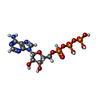
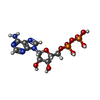



| #13: Chemical | ChemComp-ATP / | ||
|---|---|---|---|
| #14: Chemical | ChemComp-ADP / #15: Chemical | ChemComp-ZN / | |
-Details
| Has ligand of interest | N |
|---|---|
| Has protein modification | N |
-Experimental details
-Experiment
| Experiment | Method: ELECTRON MICROSCOPY |
|---|---|
| EM experiment | Aggregation state: PARTICLE / 3D reconstruction method: single particle reconstruction |
- Sample preparation
Sample preparation
| Component |
| ||||||||||||||||||||||||
|---|---|---|---|---|---|---|---|---|---|---|---|---|---|---|---|---|---|---|---|---|---|---|---|---|---|
| Molecular weight |
| ||||||||||||||||||||||||
| Source (natural) |
| ||||||||||||||||||||||||
| Source (recombinant) |
| ||||||||||||||||||||||||
| Buffer solution | pH: 8 | ||||||||||||||||||||||||
| Buffer component |
| ||||||||||||||||||||||||
| Specimen | Embedding applied: NO / Shadowing applied: NO / Staining applied: NO / Vitrification applied: YES | ||||||||||||||||||||||||
| Specimen support | Details: Negative Polarity / Grid material: COPPER / Grid mesh size: 200 divisions/in. / Grid type: Quantifoil R2/1 | ||||||||||||||||||||||||
| Vitrification | Instrument: LEICA EM GP / Cryogen name: ETHANE / Humidity: 95 % / Chamber temperature: 283 K |
- Electron microscopy imaging
Electron microscopy imaging
| Experimental equipment |  Model: Titan Krios / Image courtesy: FEI Company |
|---|---|
| Microscopy | Model: TFS KRIOS |
| Electron gun | Electron source:  FIELD EMISSION GUN / Accelerating voltage: 300 kV / Illumination mode: FLOOD BEAM FIELD EMISSION GUN / Accelerating voltage: 300 kV / Illumination mode: FLOOD BEAM |
| Electron lens | Mode: BRIGHT FIELD / Nominal defocus max: 2900 nm / Nominal defocus min: 1100 nm / Cs: 2.7 mm |
| Image recording | Electron dose: 1.029 e/Å2 / Film or detector model: GATAN K2 SUMMIT (4k x 4k) |
- Processing
Processing
| EM software |
| ||||||||||||||||||||||||||||||||||||||||
|---|---|---|---|---|---|---|---|---|---|---|---|---|---|---|---|---|---|---|---|---|---|---|---|---|---|---|---|---|---|---|---|---|---|---|---|---|---|---|---|---|---|
| CTF correction | Type: PHASE FLIPPING AND AMPLITUDE CORRECTION | ||||||||||||||||||||||||||||||||||||||||
| Particle selection | Details: Minimum particle diameter (A) = 120 Maximum particle diameter (A) = 240 | ||||||||||||||||||||||||||||||||||||||||
| 3D reconstruction | Resolution: 3.55 Å / Resolution method: FSC 0.143 CUT-OFF / Num. of particles: 64537 / Symmetry type: POINT | ||||||||||||||||||||||||||||||||||||||||
| Atomic model building | Protocol: FLEXIBLE FIT / Space: RECIPROCAL / Target criteria: MAXIMUM LIKELIHOOD WITH PHASES |
 Movie
Movie Controller
Controller



 PDBj
PDBj
